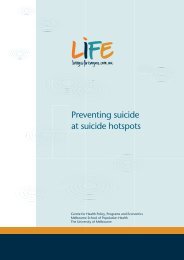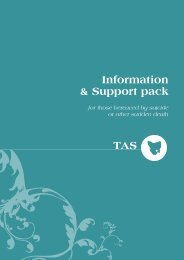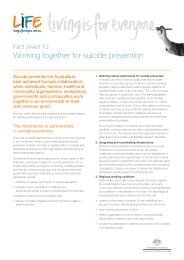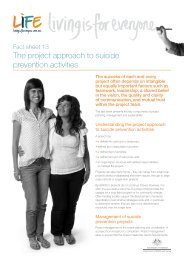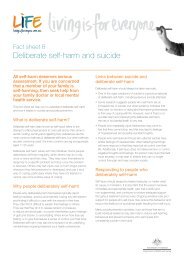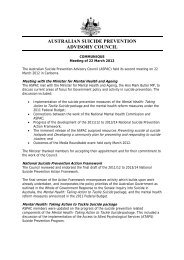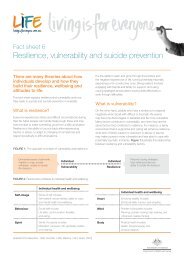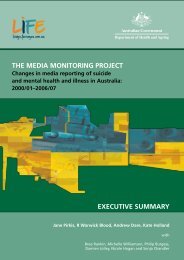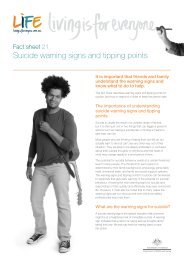SUICIDE in RURAL & REMOTE AREAS of AUSTRALIA - Living is for ...
SUICIDE in RURAL & REMOTE AREAS of AUSTRALIA - Living is for ...
SUICIDE in RURAL & REMOTE AREAS of AUSTRALIA - Living is for ...
Create successful ePaper yourself
Turn your PDF publications into a flip-book with our unique Google optimized e-Paper software.
14<br />
Suicide <strong>in</strong> rural and remote areas <strong>of</strong> Australia<br />
with<strong>in</strong> culture <strong>in</strong> terms <strong>of</strong> ‘sorry cuts’ or ‘anger cuts’;<br />
here, there may be no <strong>in</strong>tention to die but desires<br />
to cope with seem<strong>in</strong>gly unbearable pa<strong>in</strong>, relieve<br />
stress, express rage or seek attention (Ollapallil et<br />
al, 2008).<br />
Migrants are another group that may prove<br />
vulnerable to self-harm and suicidal behaviours<br />
with<strong>in</strong> a rural environment, especially young men.<br />
While research has <strong>in</strong>dicated that suicide r<strong>is</strong>k tends<br />
to be lower among migrants <strong>in</strong> Australia overall, a<br />
study undertaken <strong>in</strong> New South Wales <strong>in</strong>dicated<br />
that migrants males had a higher suicide rate when<br />
they lived <strong>in</strong> ‘non-metropolitan’ areas (Morrell et al,<br />
1999). However, the suicide rates <strong>of</strong> female migrants<br />
did not change signifi cantly depend<strong>in</strong>g upon their<br />
geographical location. It can be argued that these<br />
higher suicide rates are connected to a lack <strong>of</strong> social<br />
connectedness and <strong>in</strong>creased social d<strong>is</strong>location<br />
felt by migrants <strong>in</strong> small communities, especially<br />
if they hail from non-Engl<strong>is</strong>h-speak<strong>in</strong>g countries.<br />
Mac<strong>in</strong>tyre et al (2002) refers to the challenges<br />
faced by migrants <strong>in</strong> these rural geographical areas<br />
as ‘<strong>in</strong>compatible status’.<br />
Much has been written about the high rates <strong>of</strong> suicidal<br />
behaviours among Australian youth, especially high<br />
among those youth liv<strong>in</strong>g <strong>in</strong> rural areas. Between<br />
1999 and 2003, research <strong>in</strong>dicated that the gap<br />
between the suicide rates <strong>of</strong> males aged 25-34 years<br />
liv<strong>in</strong>g <strong>in</strong> metropolitan and remote areas <strong>in</strong>creased<br />
signifi cantly (Page et al, 2007). A signifi cant <strong>in</strong>crease<br />
<strong>in</strong> rural female suicide was also demonstrated (Ibid.).<br />
Bourke (2003) has conducted <strong>in</strong>-depth <strong>in</strong>terviews<br />
with rural youth about suicide. She has found that<br />
youth are vulnerable when they are marg<strong>in</strong>al<strong>is</strong>ed<br />
from their community; th<strong>is</strong> may happen if they reject<br />
(either voluntarily or <strong>in</strong>voluntarily) the prevail<strong>in</strong>g<br />
community norms regard<strong>in</strong>g un/acceptable attitudes<br />
and behaviours (Barnes et al, 2004; Bourke, 2003,<br />
2001). These norms may be different <strong>for</strong> males and<br />
females but the negative consequences attached<br />
to non-con<strong>for</strong>mity rema<strong>in</strong>s the same. Further, when<br />
faced with life stressors, there may have been few<br />
adults capable, competent or will<strong>in</strong>g to provide<br />
ass<strong>is</strong>tance to a young person <strong>in</strong> cr<strong>is</strong><strong>is</strong>. Bourke found<br />
that: “For the most part, teachers did not want to be<br />
counsellors and <strong>in</strong>dicated that it was problematic to<br />
know about a student’s problems while also be<strong>in</strong>g<br />
a local resident and perhaps a friend <strong>of</strong> the young<br />
person’s parents” (2003, p. 2361). Nor did young<br />
people appear to always d<strong>is</strong>cuss their suicidal<br />
ideation with their peers. Responses from Bourke’s<br />
(2003) research appeared to <strong>in</strong>dicate that some<br />
young people saw suicidal ideation as a ‘one-<strong>of</strong>f’<br />
experience which occurred <strong>in</strong> state <strong>of</strong> irrationality;<br />
<strong>in</strong> th<strong>is</strong> way, they had no tools with which to more<br />
effectively combat any future ideation. Further, young<br />
men may be more prone to react<strong>in</strong>g aggressively<br />
to problems, <strong>in</strong>clud<strong>in</strong>g physical altercations with<br />
others, which “…was accepted as ‘the way it <strong>is</strong>’. Is<br />
it any wonder, then, that when the problem <strong>is</strong> the<br />
self, resolution <strong>is</strong> via self-harm” (Bourke, 2003, p.<br />
2361; see also Qu<strong>in</strong>e et al, 2003).<br />
GriffithBook FINAL 20/09.<strong>in</strong>dd 14<br />
15/11/12 4:28 PM





